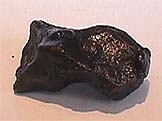The Story of Meteorites

Meteorites
Source: World-wide. Perhaps the best places that scientists look for meteorites is in the Arctic regions covered in snow. About the only way a rock is going to be out on top of the snow cover is if it fell out of the sky. Which is indeed how they get there. So many expeditions to the Arctic and Antarctic regions are for the collection of meteorites.
Chemical: A wide variety possible. The one shown above is an iron meteorite that was once inside the core of a star and was blown out into the cosmos for a few eons of time until it landed in Siberia in the 192-‘s. Others are stony and were probably once a part of the asteroid belt where scientists believe that a planet blew up scattering the stones throughout the solar system. Of note to this concept: it should be noted that many stony meteorites contain a high level of olivene group minerals, and some have been found to have peridot crystals in, and on, them. So there is much to the story about meteorite origins that we can hope to learn in the near future. (some scientists have even theorized that some will contain diamonds….). And a handful have come to earth from Mars are have been reported to contain fossilized bacteria. Who know???
Crystal System: None.
Formation: Literally out of this world.
Properties: Any number of possibilities. The iron meteorites will have smooth edges as shown above while the stony meteorites will have any combination. The largest meteor crater in the United States if the Meteor Crater in Arizona, which is not to be missed if you are going through that area.

